Brahminy Blind Snake
Brahminy Blind Snake is a VERY COMMON non-venomous snake which is in nearly every country across the world. It is a myth that Brahminy blind snakes are venomous and deadly. Here in Thailand, it is a pervasive myth. There are many kinds of blind snakes in Thailand, and also some small legless skinks that resemble snakes.
These snakes resemble thin black worms in Thailand. They have a lot of energy when you pick one up. You will likely find them in the soil in your potted plants or climbing up through your drain in your restroom.
Brahminy Blind Snakes are completely harmless, though they may bite.
[Page Updated: 19 July 2023]
Ramphotyphlops braminus (Brahminy Blind Snake)
Thai: (ngoo din ban)
Length: Up to about 6 inches (15cm)
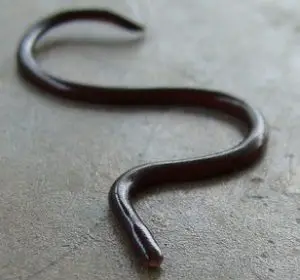
Description: Small black or brown snakes resembling shiny worms. Upon closer inspection, small scales and a mouth that opens can be seen. Looking very closely you can see 2 black eyes.
Range: All over Thailand and much of the world, native to Southeast Asia. Transported across the world in potted plants.
Notes: These are ground-dwelling and burrowing snakes. They are shy. They are easily eaten by many other predators like birds, monitors, and other snakes. The Red Tailed Pipe snake eats these snakes often. The blind snakes have very small eyes covered with thin skin that protects them as they burrow through the dirt.
Many people have this tiny black snake come up through the pipes into their homes. We found dozens of them in our home, having come through the shower drain. They are completely harmless and yet there are rumors across the world that these are deadly snakes capable of killing humans with one bite. It is completely false. Do not kill these snakes, they are beneficial to the environment – they eat termite and ant eggs.
Active Time? Anytime. I have found them at night and daylight – under leaves or other litter on damp ground, and of course, crawling up through our drains.
Food: Ant and termite eggs primarily.
Defensive Behavior: Flip around crazily and will attempt to flee. The mouth is too small to inflict a bite on humans, and I have never seen one of these small snakes attempt to bite.
Venom Toxicity: No venom or means to inject it.
Offspring: An interesting twist here. Brahminy Blind snakes are all born female and need no males to continue the species (parthenogenic). They are parthenogenetic. When they reach sexual maturity they lay fertile eggs – and hence, are fully self-perpetuating the species. If there is one – soon there will be more!
These snakes have populated much of the Western world and can be found in Thailand, India, Hawaii, Louisiana, Boston, and other places in the USA and across the globe now.
My Brahminy Blind Snake Video:
Brahminy Blind Snake Scientific Classification
Kingdom: Animalia
Phylum: Chordata
Subphylum: Vertebrata
Class: Reptilia
Order: Squamata
Suborder: Serpentes
Family: Typhlopidae
Genus: Ramphotyphlops
Species: R. braminus
Binomial classification:
Ramphotyphlops braminus
- Common Non-Venomous Snakes Post #1 Post #2
- Brahminy Blind Snake
- Brown Kukri Snake
- Copper-Headed Racer / Radiated Rat Snake | IndoChinese Rat Snake | Oriental Rat Snake / Banded | Red-Tailed Racer | Ridley’s Racer | White-Bellied Rat Snake
- Dragon Snake
- Laotian Wolf Snake
- Malayan Bridle Snake
- Orange-Bellied Snake
- Red-Tailed Pipe Snake
- Reticulated Python | Blood Python | Burmese Python
- Striped Bronzeback
- Sunbeam Snake

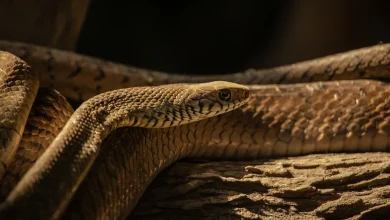
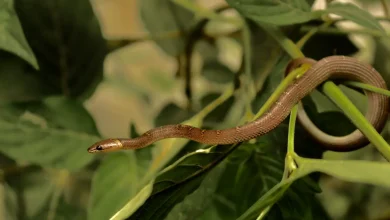
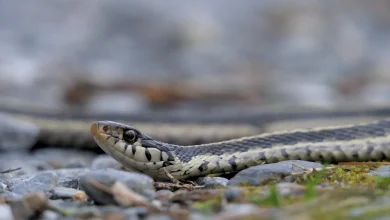
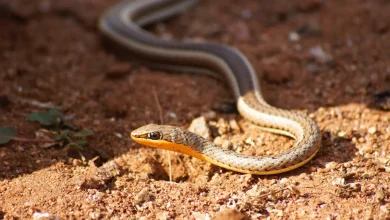
Hi, i’m from Malaysia, i stumbled with a worm like creature like the Brahminy blind snake, only his head resembles a hammerhead shark’s head. It is black in colour and about 0.5 mm in body diameter and less than a feet long. Do you have any records regarding this species? My boss said it was a planarian worm. I found it at visitor trail in Endau-Rompin National Park
I have seen them often. They are some sort of worm, not a snake. Quite amazing! I was just telling a friend about this, and he has never seen one in his garden. I find them in secondary and primary forest most often. When they move, they are like liquid – like black water, yeah? I find them fascinating, but I haven’t picked one up. You?
Hello, I am seeing a lot of people on here saying they have found (and sadly killed) these awesome snakes, I am hoping someone who lives in an area that these creatures are native to can get in touch with me about catching some and sending them to me. I will pay.
Thank You
Hi,
I had to kill so many that creeped out of the cracks under the doorway. I live on the Ground floor. I have heard about it entering the ears and causing deafness or being harmfull for the birds that eat them. Maybe now that I know they are harmless, I’ll dispose them away and not kill them. How can I help you get these? I am from Bangalore India. I am not sure if it’s legal to send stuff like these abroad. If it is legal, I can help you.
Hai sir I am Ramesh from Nethaji Snake Trust, South India, Tamilnadu, Madurai District, Usilampatti. We r Duing in Snake Research and Wildlife Rescue.
Hello Ramesh!
I am dhandapani. Often I find the tiny snake in my restroom . Are they harmful?. And heard that it secretes some fluid like substance and that causes some uncurable skin diseases like permanent patches over the skin etc . Please please tell me about that . And it is called sir paambu in tamil. Please tell me about it!!!!!!!!!
Sorry, I don’t know anything about a snake that has this ability.
We found one by the pool in Bradenton, Florida today. We were stumped because it appeared to have no discernible head but it had a tiny tongue flicking in and out. Found this website by googling “black snake with no discernible head.” Very interesting! Thank you for this great educational article to share with the kids!
Sure! Glad you found it… these things are all over the world – couple different species.
I am compiling specific localities for Indotyphlops braminus and want to hear from anyone who has seen this snake. Please email me and give me the locality where a Brahminy blindsnake was found. These data will be published in a study of the worldwide distribution of I. braminus.
Thanks for your help, Dr. Van